All throughout history, mankind has shown a particular interest in understanding, depicting and measuring the stars and its celestial bodies. Furthermore, it wasn't until very recently that a rift emerged between the disciplines of astrology and astronomy. Right up till the 20th centuries, scientists would have considered horoscopes alongside their astrolabes.¹
The tradition of depicting the skies above us is age old. In a bit of fun, we've pulled together here a couple of artworks that allude to the position of the stars in either their concepts, compositions or contexts. So whether you're a headstrong Capricorn or an expressive Gemini, there'll be an artwork here for everyone.
The tradition of depicting the skies above us is age old. In a bit of fun, we've pulled together here a couple of artworks that allude to the position of the stars in either their concepts, compositions or contexts. So whether you're a headstrong Capricorn or an expressive Gemini, there'll be an artwork here for everyone.

Horoscope of Sultan Iskandar, 1411
The Wellcome Collection

Chinese Star Chart, c. 700 AD
British Library

The Map Psalter, c. 1260s
British Library

Sferamundi, Leonardo de Pierio Dati, c. 1475
The Wellcome Collection
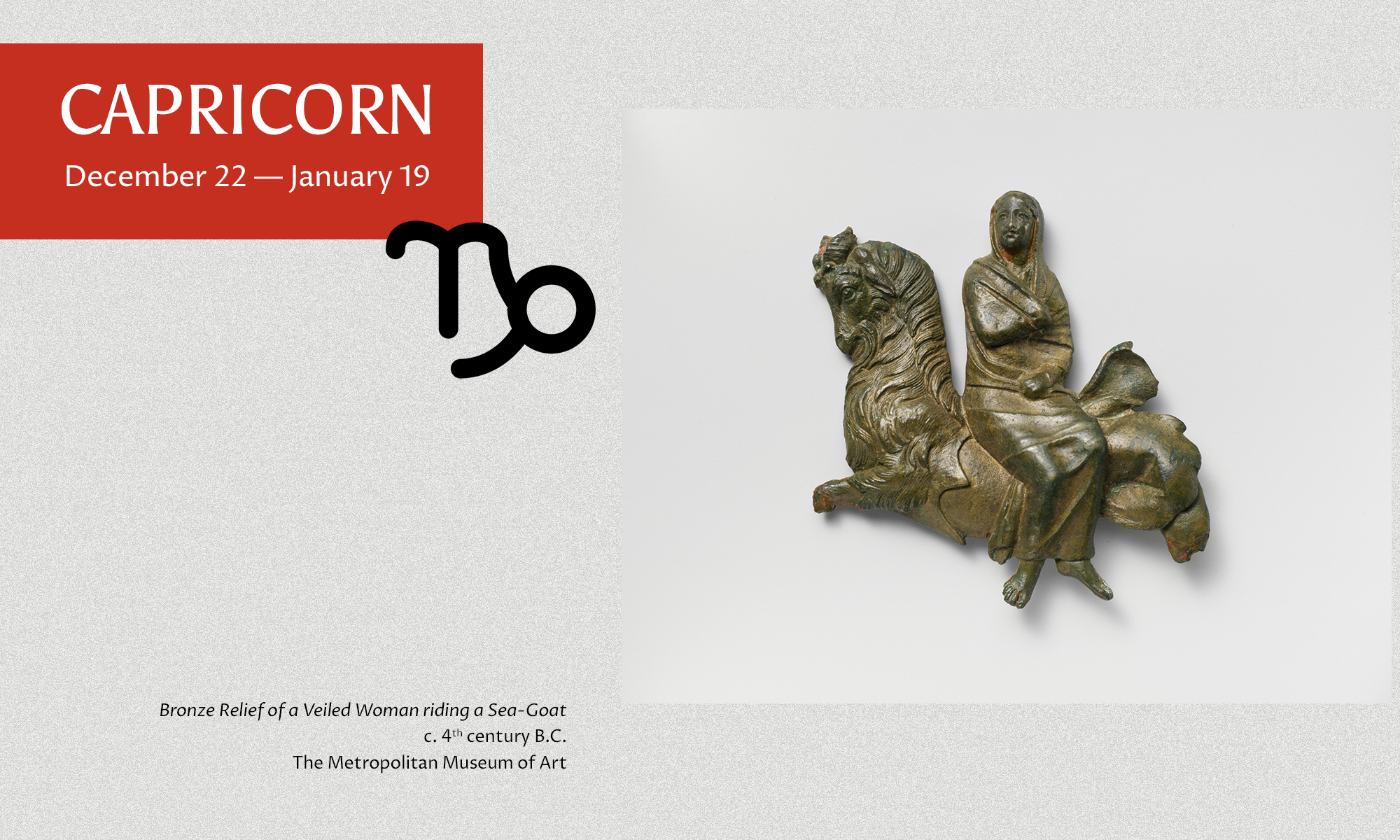
The symbol of Capricorn is the mythical creature, the sea-goat.
Evidence that the hybrid of a goat and a fish was used to denote the constellation of Capricorn since 2000 B.C.E. can be seen through Babylonian boundary stones, now in the British Museum's collection.² This later Hellenistic version shows a nereid on a sea-goat.³ This bronze object is small enough to be held in the palm of one's hand, pointing to a high level of craftsmanship in attaining its level of detail in metalworking.

The constellation of Aquarius is symbolised by the water-bearer.
Many of Kupka's works are characterised by vibrant colour palettes and allegorical subject matter. He also often explored the intersections between religion and symbolism, and this work was no different. Kupka was also an incredibly meticulous artist. Upon his death, his archive of drawings were largely donated to the MoMA. A draft sketch for the composition of Water. The Bather. can be found within this repository.⁴
Many of Kupka's works are characterised by vibrant colour palettes and allegorical subject matter. He also often explored the intersections between religion and symbolism, and this work was no different. Kupka was also an incredibly meticulous artist. Upon his death, his archive of drawings were largely donated to the MoMA. A draft sketch for the composition of Water. The Bather. can be found within this repository.⁴
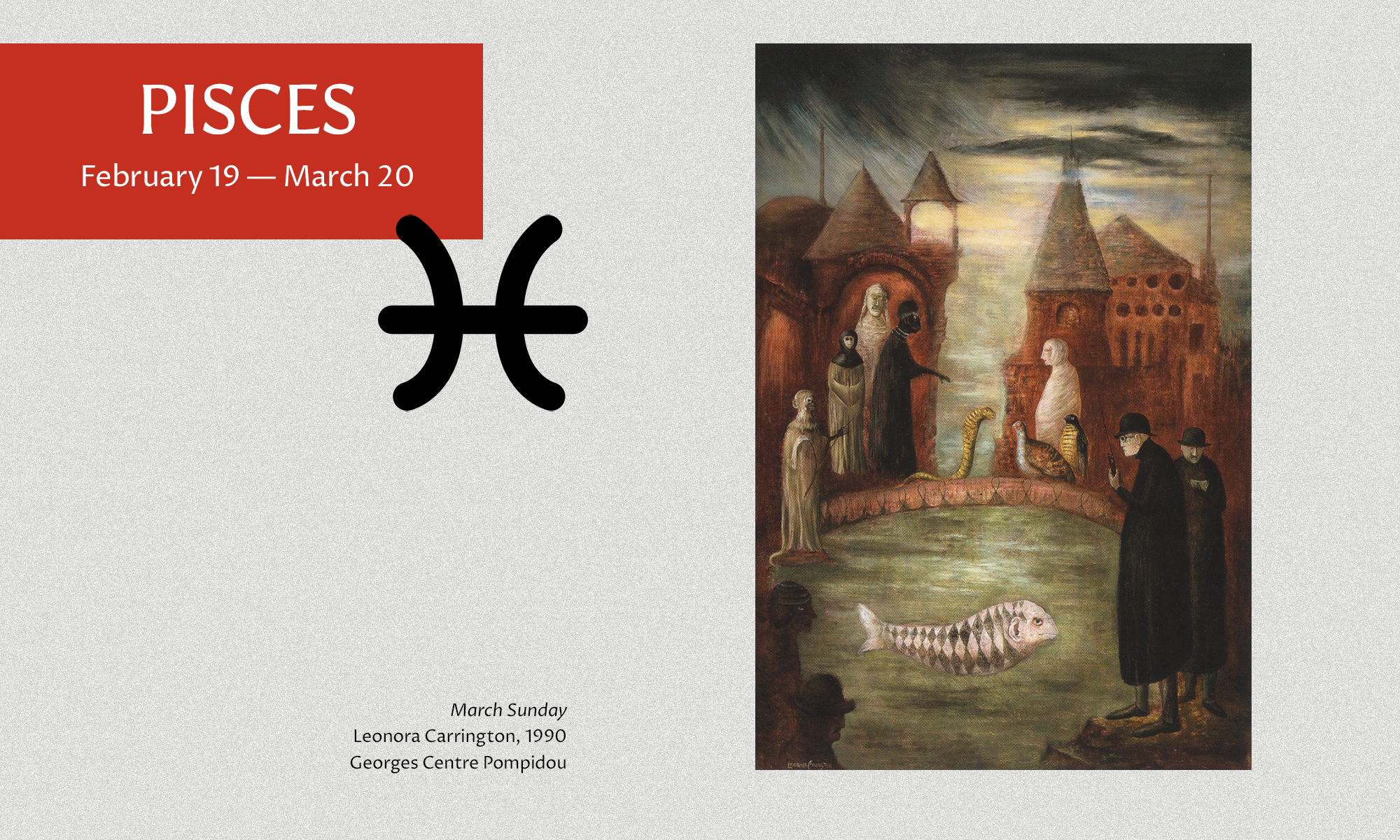
Pisces is most commonly depicted by two fish circling each other.
In this painting, a fish lies flat in a pond whilst a motley crew including men in black coats, a penguin, and a snake watch on. By the time Carrington painted this, she was a writer, sculptor and had successful solo shows at locations such as the Pierre Matisse Gallery. She worked alongside some of the greatest Surrealist artists of her time, and her works surpass the likes of Picasso and Dalí by defying easy categorisation and interpretation.
In this painting, a fish lies flat in a pond whilst a motley crew including men in black coats, a penguin, and a snake watch on. By the time Carrington painted this, she was a writer, sculptor and had successful solo shows at locations such as the Pierre Matisse Gallery. She worked alongside some of the greatest Surrealist artists of her time, and her works surpass the likes of Picasso and Dalí by defying easy categorisation and interpretation.
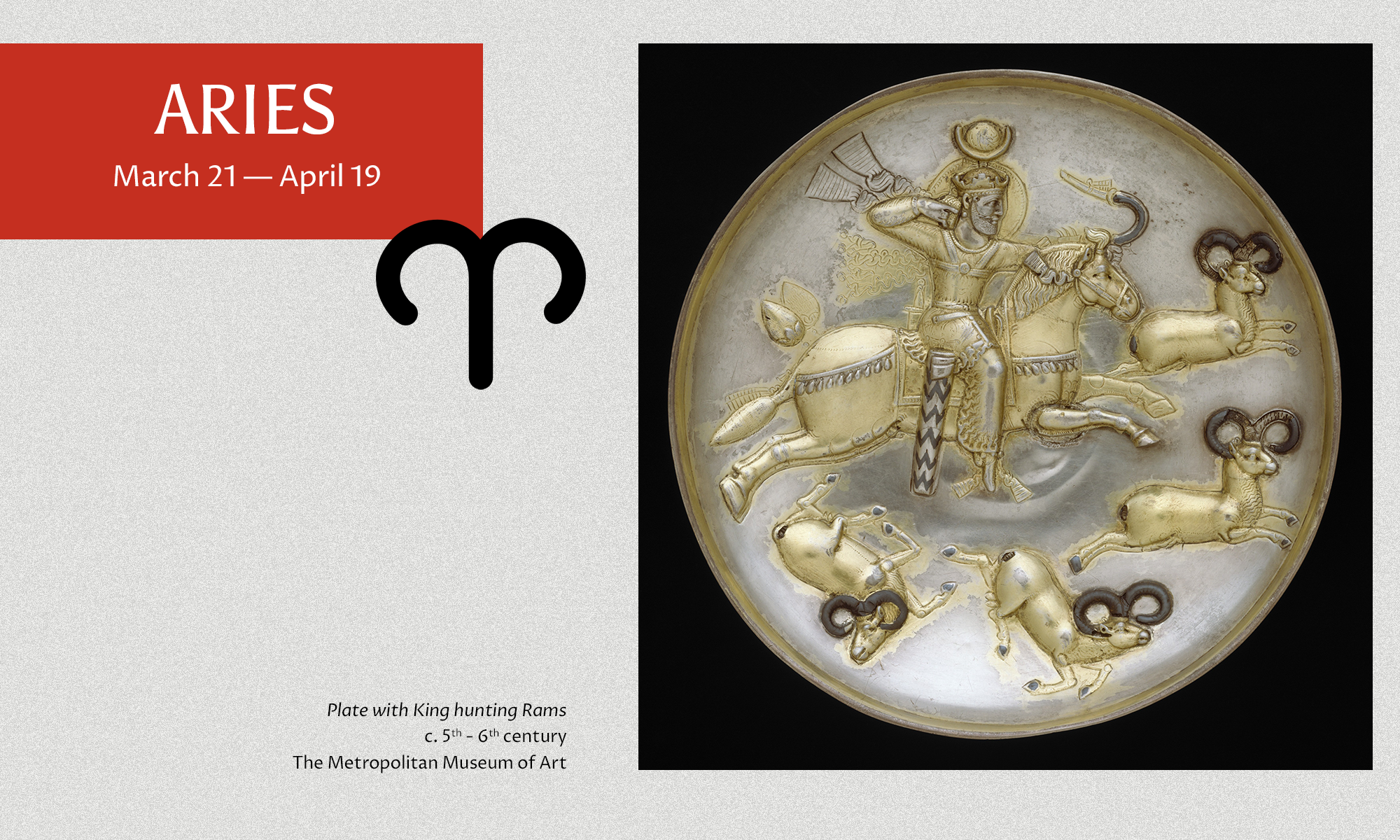
The ram is synonymous with the star sign of Aries.
The theme of the hunting king was a standard prototype that was used in royal depictions during the Sasanian period.⁵ Here, a king hunts four rams with a bow and arrow. In what is an incredibly dynamic pictorial plane, the king draws his bow as his horse gallops towards the leaping rams. This metal plate was hammered into shape, with raised silver pieces affixed to form the rams' horns.
The theme of the hunting king was a standard prototype that was used in royal depictions during the Sasanian period.⁵ Here, a king hunts four rams with a bow and arrow. In what is an incredibly dynamic pictorial plane, the king draws his bow as his horse gallops towards the leaping rams. This metal plate was hammered into shape, with raised silver pieces affixed to form the rams' horns.

Those born under the star-sign of Taurus are characterised as fun-loving yet stubborn, much like the bull that symbolises it.
In this interactive installation, audiences are invited to ride a bull in the middle of an inflatable pen. As soon as the viewer gets onto the bull, it deflates, forcing the viewer to dismount. Yet once the viewer steps away, the bull slowly inflates again. With this work, Xin turned what seemed like a simple carnival game into a subversive commentary on power dynamics.⁶
In this interactive installation, audiences are invited to ride a bull in the middle of an inflatable pen. As soon as the viewer gets onto the bull, it deflates, forcing the viewer to dismount. Yet once the viewer steps away, the bull slowly inflates again. With this work, Xin turned what seemed like a simple carnival game into a subversive commentary on power dynamics.⁶

The constellation of Gemini is commonly represented by a pair of twins.
This is a portrait of two wealthy men, who were friends, alongside their prized possessions. Surrounded by musical and scientific instruments, the men evidently wanted to give this portrait to give others an impression of their erudition.⁷ Interestingly, the long stretch at the bottom of the painting is an optical illusion, forming a skull when one moves to view the work from the left.
This is a portrait of two wealthy men, who were friends, alongside their prized possessions. Surrounded by musical and scientific instruments, the men evidently wanted to give this portrait to give others an impression of their erudition.⁷ Interestingly, the long stretch at the bottom of the painting is an optical illusion, forming a skull when one moves to view the work from the left.

A crab illustrates the star-sign of Cancer.
Tillmans' works are casual and informal. He photographs how a single book page folds, or how waves wash up onto the shore. His works display a reverence for colour, light, texture, and the vernacular. At the same time, he makes clear allusions to art history. In Dutch still life paintings, flies were sometimes painted amidst luscious fruits and flowers. Flies were seen as a symbol of death, and so to have one photographed with a crab's carcass is both fitting and poignant.⁸
Tillmans' works are casual and informal. He photographs how a single book page folds, or how waves wash up onto the shore. His works display a reverence for colour, light, texture, and the vernacular. At the same time, he makes clear allusions to art history. In Dutch still life paintings, flies were sometimes painted amidst luscious fruits and flowers. Flies were seen as a symbol of death, and so to have one photographed with a crab's carcass is both fitting and poignant.⁸

The fiery lion is the face of Leo, an equally fiesty astrological sign.
This lion shaped ceramic vessel is covered with a turquoise enamel slip. Turquoise occurs naturally in Iran, in regions such as Nishapur, and was used extensively in the decorating of ceramic tiles and metal objects. This particular object has openings at the top, which has led to the museum's catalogue listing it as a water vessel.⁹ Aside from water, it could have carried other liquids, such as perfumes or medicines.
This lion shaped ceramic vessel is covered with a turquoise enamel slip. Turquoise occurs naturally in Iran, in regions such as Nishapur, and was used extensively in the decorating of ceramic tiles and metal objects. This particular object has openings at the top, which has led to the museum's catalogue listing it as a water vessel.⁹ Aside from water, it could have carried other liquids, such as perfumes or medicines.

Much like what its name suggest, Virgo is symbolised by a maiden.
This Renaissance masterpiece depicts the striking beauty and divinity of the goddess of love. On her left, Zephyrus and Aura gently create a breeze that moves Venus towards the shore. The Hora of Spring rushes forward to meet and clothe the naked goddess. The allegorical nature of this work suggests that Botticelli was drew heavily from Classical artworks, many of which were displayed in the Vatican City.
This Renaissance masterpiece depicts the striking beauty and divinity of the goddess of love. On her left, Zephyrus and Aura gently create a breeze that moves Venus towards the shore. The Hora of Spring rushes forward to meet and clothe the naked goddess. The allegorical nature of this work suggests that Botticelli was drew heavily from Classical artworks, many of which were displayed in the Vatican City.
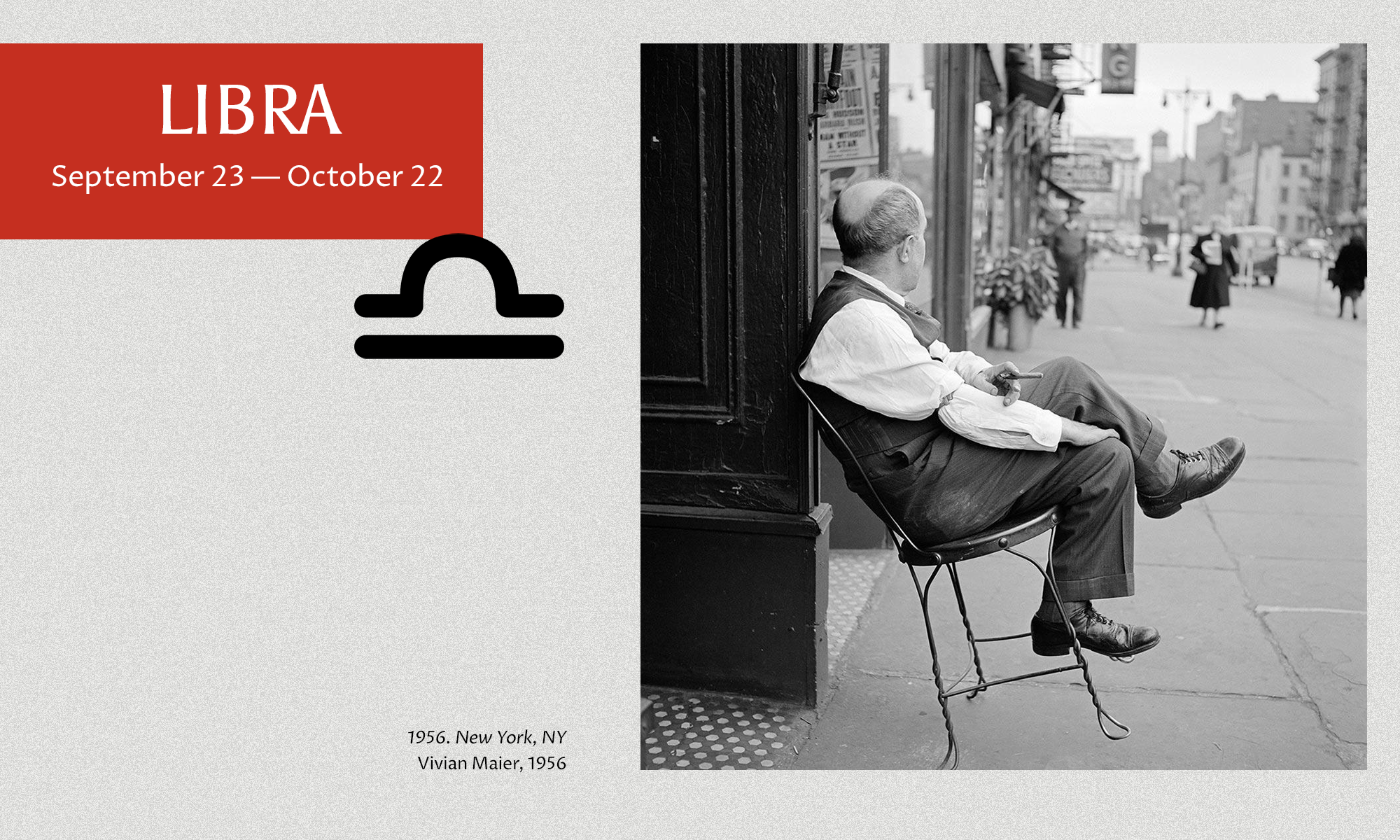
Representing Libra is a set of balancing scales, which is the only non-animate symbol in the zodiac.
Vivian Maier's photographs of everyday life in New York City were discovered when Chicago-based collectors purchased boxes full of her negatives by chance.¹⁰ Her ability to immortalise seemingly ordinary moments is epitomised here, where a man sits precariously perched on a chair. As he tilts backwards, the viewer is left questioning if he manages to balance himself or if he falls flat just seconds later.
Vivian Maier's photographs of everyday life in New York City were discovered when Chicago-based collectors purchased boxes full of her negatives by chance.¹⁰ Her ability to immortalise seemingly ordinary moments is epitomised here, where a man sits precariously perched on a chair. As he tilts backwards, the viewer is left questioning if he manages to balance himself or if he falls flat just seconds later.
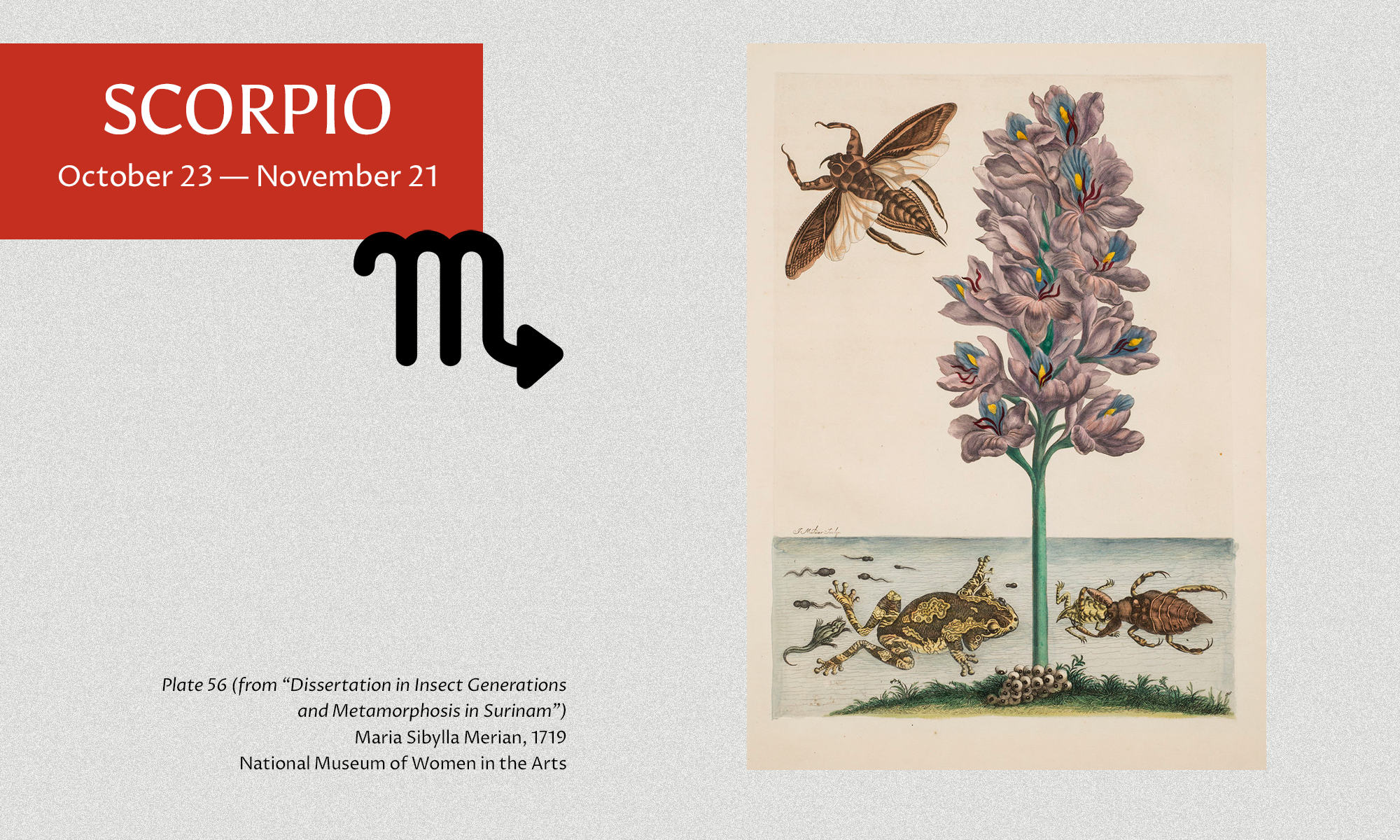
The astrological sign of Scorpio is represented by, quite predictably, the scorpion.
This illustration depicts a water scorpion, alongside a moth and a toad. In Merian's distinct style, she depicted the natural habitats of these animals, whilst incorporating her agency as an artist within these images. In a time where such fields of study were dominated by men, her work pioneered novel new concepts.¹¹ Her findings were profoundly influential, and later scientific discoveries actually proved some of them accurate.
This illustration depicts a water scorpion, alongside a moth and a toad. In Merian's distinct style, she depicted the natural habitats of these animals, whilst incorporating her agency as an artist within these images. In a time where such fields of study were dominated by men, her work pioneered novel new concepts.¹¹ Her findings were profoundly influential, and later scientific discoveries actually proved some of them accurate.

Last, but definitely not the least, the archer is the symbol for the last star sign for the year, Sagittarius.
Harriet Lee-Merrion is an award-winning illustrator, whose works engage in a continuous examination about femininity and identity. In terms of artistic influences, the artist cites "miniature paintings, Japanese woodblock prints, Modernist architecture, Surrealism, old medical diagrams, botanical drawings, pre-Raphaelite paintings, and old theatre posters." — just to name a few.¹²
Harriet Lee-Merrion is an award-winning illustrator, whose works engage in a continuous examination about femininity and identity. In terms of artistic influences, the artist cites "miniature paintings, Japanese woodblock prints, Modernist architecture, Surrealism, old medical diagrams, botanical drawings, pre-Raphaelite paintings, and old theatre posters." — just to name a few.¹²
If you've enjoyed our little gallop through space, consider diving deeper into the history of astronomy with this twitter account, @HistAstro. Run by a curator at the Museum of Science and Industry in Chicago, their feed is a treasure trove of astrolabes, globes and other astronomical instruments.
FOOTNOTES:
¹ Gilbert, Robert Andrew and David E. Pingree. "Astrology". Encyclopaedia Britannica. http://www.britannica.com/topic/astrology. Accessed 28 June, 2018.FOOTNOTES:
² A Babylonian boundary stone at the British Museum that dates back to the Middle Babylonian period shows a goat-fish amidst stars and lunar discs.
³ "Bronze relief of a veiled woman riding a sea-goat". The Metropolitan Museum of Art. Accessed 28 June, 2018.
⁴ A prepatory sketch for the human figure in Water. The Bather. can be found in the MoMA's collection, evidencing that Kupka carefully considered how best to compose his artworks before executing them.
⁵ "Plate with king hunting rams". The Metropolitan Museum of Art. Accessed 28 June, 2018.
⁶ "Xin Yunpeng, No Problem (辛云鹏《没问题》)". Google Arts & Culture. Accessed 28 June, 2018.
⁷ "Hans Holbein the Younger | The Ambassadors". The National Gallery. Accessed 28 June, 2018.
⁸ Pound, Cath. "Secret symbols in still life paintings". BBC Culture. Accessed 28 June, 2018.
⁹ "Model". Victoria & Albert Museum. Accessed 28 June, 2018. ¹⁰ "History". Vivian Maier. Accessed 28 June, 2018.
¹¹ "The Woman Who Made Science Beautiful". The Atlantic. Accessed 28 June, 2018.
¹² "Harriet Lee-Merrion | Illustrator". Together & Sunspell. Accessed 28 June, 2018.
¹³ Zodiac icons from Freepik.
